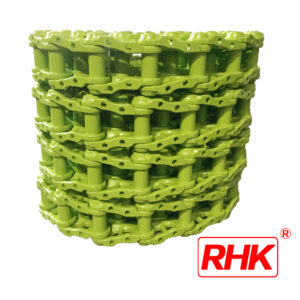An industry track link is a component of a track system that is used to support the weight of heavy machinery such as excavators, bulldozers, and other construction equipment. The track link is responsible for transferring the weight of the machine to the ground and providing traction for movement.
Here are some key features of industry track links:
Durability: Industry track links are typically made of high-strength materials such as steel or other alloys to ensure durability and resistance to wear and tear.
Precision: Industry track links are designed to precise specifications to ensure proper fit and alignment with other components such as pins, bushings, and shoes.
Low maintenance: Industry track links require minimal maintenance over their lifespan, but regular inspection and lubrication can help to extend their lifespan and ensure optimal performance.
Compatibility: Industry track links come in various sizes and designs to accommodate different types of machinery and track systems. It is important to select the correct track link for your specific application to ensure proper fit and performance.
Performance: Industry track links are designed to provide reliable and efficient performance in a range of operating conditions, such as uneven terrain, high loads, and harsh environments.
Testing: Industry track links are rigorously tested to ensure that they meet the required performance standards, such as load capacity, wear resistance, and fatigue strength.
Proper installation and maintenance are important to ensure the reliable and efficient operation of industry track links. This includes regular inspection and lubrication, as wellas proper alignment and tensioning of the track system. It is also important to follow any manufacturer recommendations or industry standards for installation and maintenance procedures.
In summary, industry track links are an essential component of track systems for heavy machinery, providing durability, precision, low maintenance, industry Track Link manufacturers compatibility, and reliable performance. It is important to select the correct track link for your specific application and follow proper installation and maintenance procedures to ensure optimal performance and extend their lifespan.
Selecting the correct track link for your machinery is important to ensure optimal performance and reliability of your track system.
Here are some steps you can take to select the correct track link:
Consult your machinery manual: Your machinery manual will provide information on the type and size of track link required for your specific machine. This is a good starting point for selecting the correct track link.
Determine the pitch and width: The pitch and width of the track link are important factors to consider when selecting the correct track link. The pitch is the distance between the center of one link pin to the center of the next, while the width is the distance from the inside of the track link shoe to the outside of the opposite shoe.
Determine the number of links: The number of links required for your track system will depend on the size of your machinery and the desired track length. You can calculate the number of links required by dividing the total length of the track by the pitch of the track link.
Consider the application: The application of your machinery will also affect the selection of the correct track link. For example, if your machinery will be operating on soft ground or in muddy conditions, you may need a wider track link to provide better traction and prevent slippage.
Choose a reputable supplier: It is important to choose a reputable supplier with a good track record of providing high-quality track links. Look for a supplier that offers a warranty or guarantee on their products.
Consultwith a track system expert: If you are unsure about the correct track link for your machinery, it is always best to consult with a track system expert. They can help you to determine the most appropriate track link for your specific needs based on factors such as the pitch, width, number of links, and operating conditions.
Overall, selecting the correct track link for your machinery is an important part of ensuring the reliable and efficient operation of your track system. By following these steps and consulting with an expert, you can choose the right track link for your specific application and achieve optimal performance and longevity of your track system.
